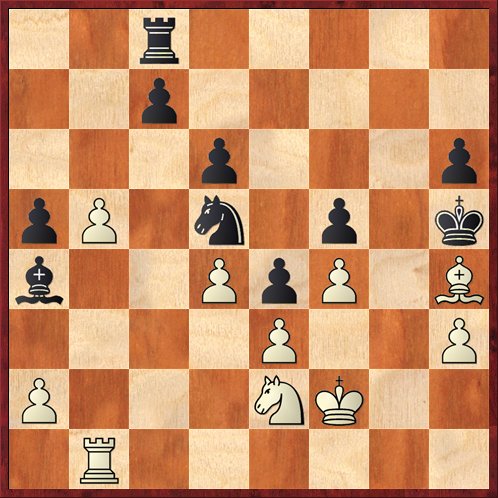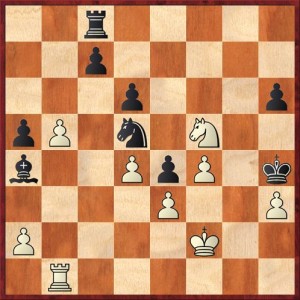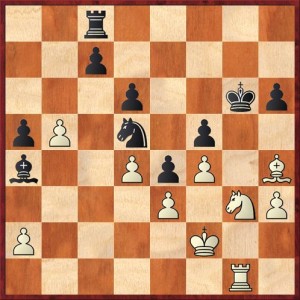In my last post I wrote about one of the most ubiquitous kinds of mistakes, in life as well as chess: the kind of mistake where you assume you know what is going on, and the assumption seems so obvious to you that you aren’t even aware of making it.
Here’s a nice chessboard example of this kind of mistake.
Last weekend I analyzed a game I played on New Year’s Day against Rayan Taghizadeh, who is currently the #5-rated 10-year-old in the country with a rating of 2078. At the time of this game his rating was around 1980, so he has gone up 100 points in just a little over four months! That shows you how rapidly he is improving.
The game ended in a very curious fashion. It was even for the first 35 moves, and in fact on move 35 I could have basically forced a draw. But I wanted to play for a win. As so often happens, in trying too hard to win I played a dreadful series of moves, and by move 44 I was in desperate circumstances.
FEN: 2r5/2p5/3p3p/pP1n1p1k/b2PpP1B/4P2P/P3NK2/1R6 w – – 0 45
Here Rayan has just played 44. … Kh5, attacking my bishop. Now I saw a surprising opportunity to stop the downward death spiral of my position. Do you see what my saving move was?
(Space inserted in case you want to think about it.)
The answer is 45. Ng3+! You want my bishop? Go ahead and take it!
Well, there isn’t much of a choice for Black here. If he plays 45. … Kg6 White could just try for a three-fold repetition with 46. Ne2. However, even better, White could play 46. Rg1, setting up a murderous discovered check threat. If 46. … Kf7 to get out of the discovered check, White plays 47. Nxf5 and the tide is very definitely turning in White’s favor.
So Rayan played 45. … Kxh4 46. Nxf5+.
FEN: 2r5/2p5/3p3p/pP1n1N2/b2PpP1k/4P2P/P4K2/1R6 b – – 0 46
Now Rayan wisely avoided taking the poisoned h-pawn. If 46. … Kxh3?? it’s mate in two: 47. Rh1+ Kg4 48. Nxh6 mate! A nice “out-of-the-blue” combination. Instead he played 46. … Kh5, and I slammed the door shut with 47. Rg1, and the game concluded 47. … Nf6 48. Ng7+, with a draw by repetition. Ironically, thirteen moves earlier I would have been disappointed with a draw, but now I was quite relieved!
So what does this have to do with questioning assumptions? Well, somewhere in the analysis I have given you, I have deliberately written a lie. But it’s a lie that I told myself during the game, and I suspect that it’s a lie that Rayan told himself too. We were both guilty of making an incorrect assumption. I didn’t realize it until I looked at the position with Rybka yesterday.
Have you found the lie yet? It’s after 45. Ng3+. I wrote that Black could not play 45. … Kg6 because of “46. Rg1, setting up a murderous discovered check threat.” Those are pretty much the words I used in my head when I was thinking about the position. But it’s not true! The only one getting murdered is White.
FEN: 2r5/2p5/3p2kp/pP1n1p2/b2PpP1B/4P1NP/P4K2/6R1 b – – 0 46
Here Rybka came up with the amazing, cold-blooded move 46. … Rf8! Now if White plays his “murderous” discovered check 47. Nxe4+ Kh5! White has two pieces en prise! You might say, “Wait a minute, can’t White just go 47. Ng3+ as before?” But it’s different now, because after 47. Ng3+ Kxh4, White doesn’t have 48. Nxf5+. Even though Black’s king seems to be in a mating net, White has no way of delivering check. Meanwhile, Black is simply a piece up and has lots of useful moves, such as … Bxb5 and … Nc3-e4, that will get him out of trouble.
Lesson 1. Not all discovered checks are murderous. Look very carefully at the followup, and don’t just assume that the side that plays the discovered check is winning. Positions with hanging pieces can be very tricky.
Lesson 2. Sometimes the best move is to take back your previous move. Psychologically this is extremely difficult to do. When I unexpectedly played 45. Ng3+ in response to his move 44. … Kh5, Black had to have the presence of mind to say, “Okay, I didn’t see that. Let me go back and look for another plan.” Indeed, if he plays 45. … Kg6 and I play some other move than Rg1, say 46. Ne2 trying for a threefold repetition, then he can play 46. … Rb8, which is what he should have done in the first place. Black just wins a pawn with a dominating position.
Lesson 3. A rook and knight can often force a draw (or even win) against a king that is trapped on the edge of the board. This is a lesson I learned a long time ago. It helped me save a draw when I was three pawns down against IM Tim Taylor (a game I showed once on ChessLecture), and remembering that fact enabled me to save a draw here, too.






{ 3 comments… read them below or add one }
What a nice swindle. This post is an exemplification of the fact that principles are useless, and that every thing in chess is tactics.
I think we can develop our ability to overcome bias by doing tactics problems in places like chesstempo (personally, I think this is where i ‘found’ my chess). Many problems are also positional in nature – sorry to pigeon hole chess in terms of crude approximations like that, but for want of a better term … – like positional piece sacs for passed pawns, etc.
I also wonder about the time situation in your game. How long did Rayan think before he bought into your bluff?
Hi Praveen, I think that only in chess can you describe something as a “nice swindle.” But yes, it was.
I don’t usually keep track of my opponents’ time on my scoresheet unless something unusual happens. In this case, I don’t remember Rayan either taking an especially long time or an especially short time before taking the bishop. Maybe a minute? That’s just a guess.
Yeah it’s just very hard to work out the complications over the board given the time at hand. But I guess, that’s where we ‘question our assumptions’, which is of course much easier said than done.
{ 2 trackbacks }